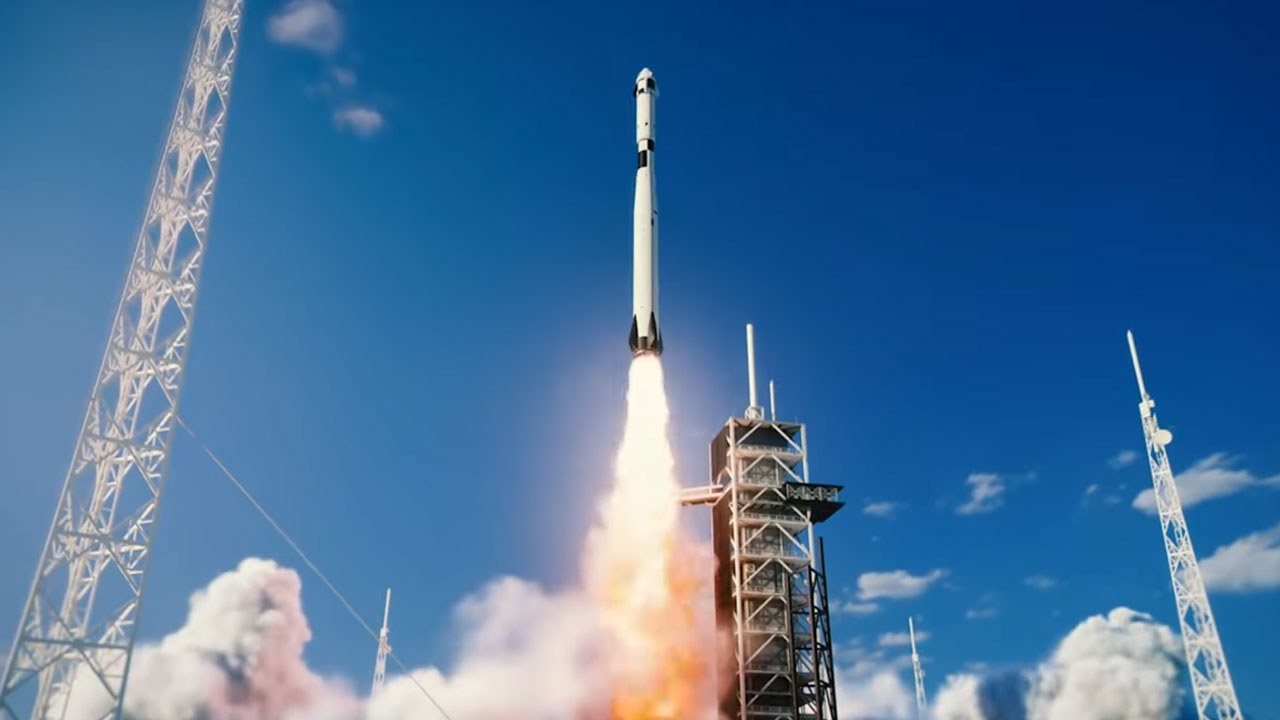Phison and Lonestar launched cornerstone of lunar data center into space last night — lands on the moon in early March
But the so-called Lonestar Freedom Data Center is only the size of a hardcover book.

Phison has collaborated with Lonestar Data Holdings on a fascinating out-of-this-world venture. On Wednesday evening, the partners proudly announced that "the First Data Center Hardware on the Moon" had been successfully launched in a SpaceX Falcon 9 rocket. If everything goes according to plan, the so-called Lonestar Freedom Data Center – packing a Phison Pascari enterprise-grade storage solution – will be operational on the moon starting March 4.
Some may consider it a stretch to call Phison's soon-to-be moon-based 8TB device a 'data center.' Perhaps the WESH 2 News (Florida) reporter on location at the Kennedy Space Center pre-launch on Wednesday was a little more candid in describing the rocket payload as "a giant flash drive."
However, leaving a giant flash drive on the moon would achieve little, so it is good to hear that this is just the origin story of "a petabyte-level, long-term mission," according to Christopher Stott, Founder and CEO of Lonestar. Lonestar Data Holdings describes itself as a lunar infrastructure and Resiliency as a Service (RaaS) firm.
So, what will constitute the fledgling Lonestar Freedom Data Center on the moon next week? The press release indicates a solar power system will run on the big cheese ball at the chosen site. A data center will also need some networking, which the official PR glosses over. Perhaps that comes later, though, as the device is referred to as a moon-based data 'backup' in the news video more than once.
We have a lot of detail about this first storage device, though. According to WESH 2's reporter, the video shows that the 'data center' sent up in the rocket is an undulating, lumpy-looking object about the size of a hardcover book.
The device's shell was 3D printed by a firm called SpaceBilt. Inside is a slice of Phison Pascari storage. Pascari enterprise-grade devices are a good choice for the moon-based data center as they are "pressure-tested to withstand cosmic radiation, harsh temperature variation, vibrations and disturbances from lunar launches and landings." As well as handling the harsh environment, the drive(s) are engineered for long-term durability and "the massive read/write cycles needed for Freedom’s intensive edge computing task," says Phison in its PR.
Shifting focus back to the WESH 2 news report, we learn that the black blob Pescari device shot to the moon features just 8TB of storage. The reporter at the launch site described the founding contents of the 'data center' as information "from heroic stories of the National Medal of Honor Museum to scanned artwork and records from dozens of nonprofit groups."
Get Tom's Hardware's best news and in-depth reviews, straight to your inbox.
If and when a proper petabyte-level data center eventually gets established on the moon, the location should be good for keeping out of harm's way from the geopolitically unstable planet Earth. The Phison PR also mentions "natural cooling" at the chosen site. According to NASA, equatorial moon weather ranges from 250°F (121°C) in daylight to -208°F (-133°C). Meanwhile, in permanent shadows, craters, or poles, temperatures lower than -410°F (-246°C) are possible. So perhaps the natural cooling comes simply from choosing a perma-shadow freezing cold location on the celestial body.
This development should probably be filed under curiosities for now.

Mark Tyson is a news editor at Tom's Hardware. He enjoys covering the full breadth of PC tech; from business and semiconductor design to products approaching the edge of reason.
-
husker Meghan Moriarty from the WESH Channel 2 news report: "Think of it as a giant flash drive built to back up the U.S.'s data in another universe."Reply
I wasn't aware that our Moon was in another universe. I wasn't even aware we could travel to other universes. -
bit_user If the premise of this is to serve as an off-planet repository of data from Earth, that's pretty dumb. NAND flash is not an archival storage medium. This thing needs to be continually powered to retain its data for any great stretch of time and I'm sure it'll fry for one reason or another in no more than a couple decades. Furthermore, sending it to the moon obviously comes at ludicrous expense. I'm sure there are much better and safer places/ways to back up your data on earth.Reply
IMO, the use case for a lunar data center would be as a data relay and cache, for probes and other lunar infrastructure. If that's not their eventual goal, then I consider it just a dumb publicity stunt.
Not to mention: what are you going to do if somebody hacks into and then bricks the thing? Like I said, power loss or breaking the firmware badly enough could lead to data loss before anyone can get up there to service it, if they don't just erase your data directly. Heh, this could turn into the most expensive-ever ransomware attack! -
bit_user Reply
Wait, there's another universe?? Where?husker said:I wasn't aware that our Moon was in another universe. I wasn't even aware we could travel to other universes. -
Notton I assume it's textbook sized to prevent cosmic ray bit flips?Reply
If so, why not a cube and increase the density further? -
bit_user Reply
Huh? How would that help? Sure, you don't want to spread everything out on a single large PCB, but the real way to deal with cosmic rays would be by burying the thing deep underground (or maybe placing at the bottom of a deep crater, lava tube, etc.). Except then, you have to deal with a separate solar array and running the power to it, not to mention a communications array located somewhere on the surface.Notton said:I assume it's textbook sized to prevent cosmic ray bit flips?
I think it's textbook-sized because every kg you land on the lunar surface is eye-wateringly expensive. Don't forget that, with no atmosphere to slow it down, you need to include enough propellant to bring it to a soft landing. -
Notton Reply
AFAIK, electronics can be shielded against cosmic ray bit flip at the component level and with additional insulation material.bit_user said:Huh? How would that help? Sure, you don't want to spread everything out on a single large PCB, but the real way to deal with cosmic rays would be by burying the thing deep underground (or maybe placing at the bottom of a deep crater, lava tube, etc.). Except then, you have to deal with a separate solar array and running the power to it, not to mention a communications array located somewhere on the surface.
I think it's textbook-sized because every kg you land on the lunar surface is eye-wateringly expensive. Don't forget that, with no atmosphere to slow it down, you need to include enough propellant to bring it to a soft landing. -
bit_user Reply
You can't shield against gamma rays with just a bit of sheet metal, or else they wouldn't be an issue. That's why I said the stuff about burying this deep underground.Notton said:AFAIK, electronics can be shielded against cosmic ray bit flip at the component level and with additional insulation material.
Satellites work pretty well with error-correcting techniques and fault-tolerance, but they're also seen as disposable and have a limited service life. I'd hazard a guess their electronics are generally "just enough" to do the job. It's very different, when you're shipping trillions of bits so they can just sit there and hopefully not decay.
Anyway, we'll see what comes of this. My guess is "not much". It's probably not more than just a gimmick, at least so far. Like I said, I can see a legit point in having some infrastructure for data caching & relay, but it's not clear to me if that's their eventual goal or if they're just going to sell "lunar data storage" to their more gullible wealthy customers.
